Since 1823 the good folks of Cologne have taken to the streets on the Monday before Ash Wednesday to mark the approach of Lent with one last day, (and night) of earthly, secular, celebration before resigning body and soul to the sanctity of abstention; the highlight being the Rosenmontag procession which weaves its way through the Altstadt Veedel on the city's left bank.
From modest beginnings the Zoch has grown to become not only the largest Rosenmontag procession in Germany, but longer than the route: the first participants arriving at the end before the last ones have left the start. We'd call that a planning issue. For Cologne it is, and as so often in the city, a solecism carried as a badge of honour.
The 2019 Rosenmontag procession is being staged under the motto Uns Sproch es Heimat, Our Language is Home, a motto chosen on the one hand to encourage all native Kölsch speakers to take a little more pride in their tongue/home and on the other to encourage non-speakers to learn, to discover a new Kölsch home.
Better understanding Cologne doesn't however necessarily require fighting with Ripuarian dialects, or indeed donning fancy dress and developing an involuntary laugh; can also be achieved by ignoring the floats and dance troops of the Rosenmontag procession and engaging instead with the architecture along the route.
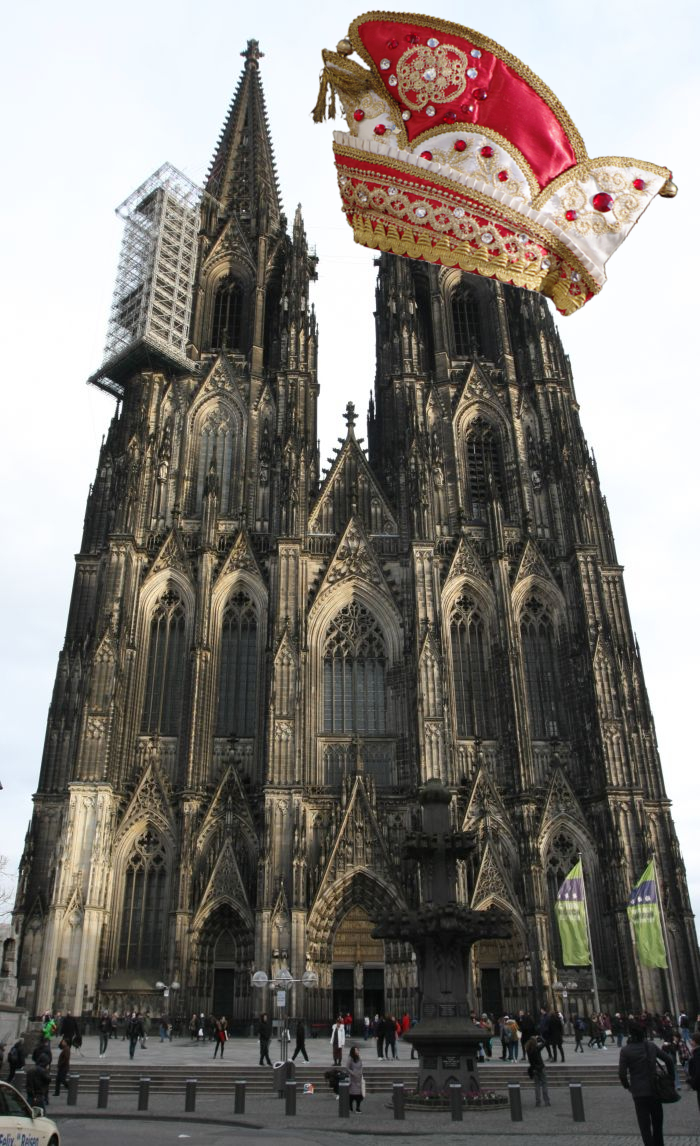
The Cologne Rosenmontag procession begins on Chlodwigplatz, which with its motley, uncontrolled, mix of the very old, the old, the newer and the contemporary irritates sensibilities more familiar with an ordered architectural syntax; is however very representative of the Cologne cityscape, that which one must interpret in order to read the city's (hi)stories, and thus is, in many regards, an apposite preface.
Passing through Severinstorburg, one of 12 gateways in the medieval city wall, the Rosenmontag procession rolls its way along Severinstrasse, whose unwavering linearity confirms that it is, yes, a former Roman road; specifically part of the main north-south Cardo Maximus which passed through Cologne on its way from Neuss to Bonn, and which also existed as a Gräberstrasse, a Road of Tombs, the Roman variation on the graveyard. One of the most notable grave finds, and back in the 1960s a matter of major public interest, was made on the contemporary Chlodwigplatz, namely the tomb of the Roman Legionnaire Lucius Poblicius. Today Chlodwigplatz's biggest visitor attraction is arguably the Kebab shop co-owned by Cologne Legionnaire Lucius Podolskius.
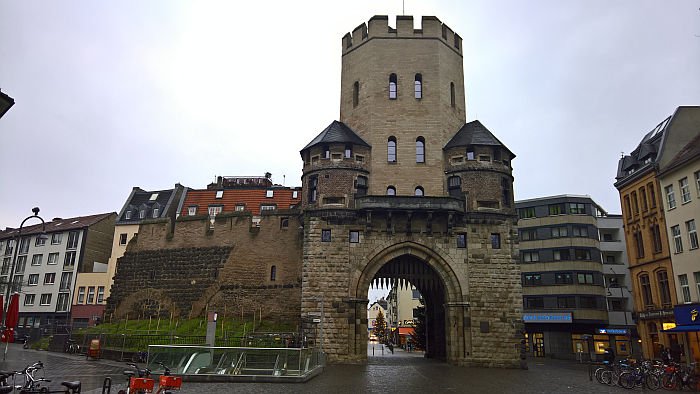
Continuing its unbroken linear path the Zoch passes by the Severinsbrücke, one of innumerate Rhein bridges in Cologne and Düsseldorf for which the German civil engineer Fritz Leonhardt was co-responsible, establishing a functional, civil, connection between Düsseldorf and Cologne proved however, even for Germany's master engineer, a bridge too far , before the gaping void on which the Stadtarchiv once stood forces the procession to deviate slightly; a deviation which does however have the advantage of bringing it closer to two interesting Cologne constructions.
Slightly off the route one finds the so-called Overstolzenhaus with its stepped gable and quietly nonchalant domination of all that surrounds it. Realised in the early 13th century by the Overstolzen patrician dynasty as a trading and family home, the Overstolzenhaus was destroyed in the Second World War, the facade however survived, and stands today as both an important document of the period and a comparison of the development of formal, decorative and ornamental vocabularies in representative architecture over the intervening eight centuries.
Behind the Overstolzenhaus stands the much more sober, yet every bit as commanding, Trinitatiskirche, the first protestant church built in arch-catholic Cologne following the city's 1815 amalgamation into Prussia. And, and as if to underscore the new dominance on the Rhein, a work by Prussian architect Friedrich August Stüler, an architect responsible for works including the Orangerie in Potsdam Sanssouci, the Neues Museum and Alte Nationalgalerie Berlin or Burg Hohenzollern in Schwarzwald, a mountain top castle whose vagaries make Ludwig II's Neuschwanstein look like some sort of Walt Disney fantasy creation.
Heading up Mühlenbach the procession rejoins the Cardo Maximus at Waidmarkt..... Waidmarkt..... why does Waidmarkt Cologne sound familiar...? Of course, how could we forget, silly us! Waidmarkt is home to the St Georg Church , a humbly unobtrusive construction and home to a cycle of 35 stained glass windows by the Dutch Art Nouveauist Johan Thorn Prikker; interesting in their own right, but also a nice reminder of the creative, artistic, exchange that occurred so freely between Holland, Belgium and Germany in the first decades of the 20th century.
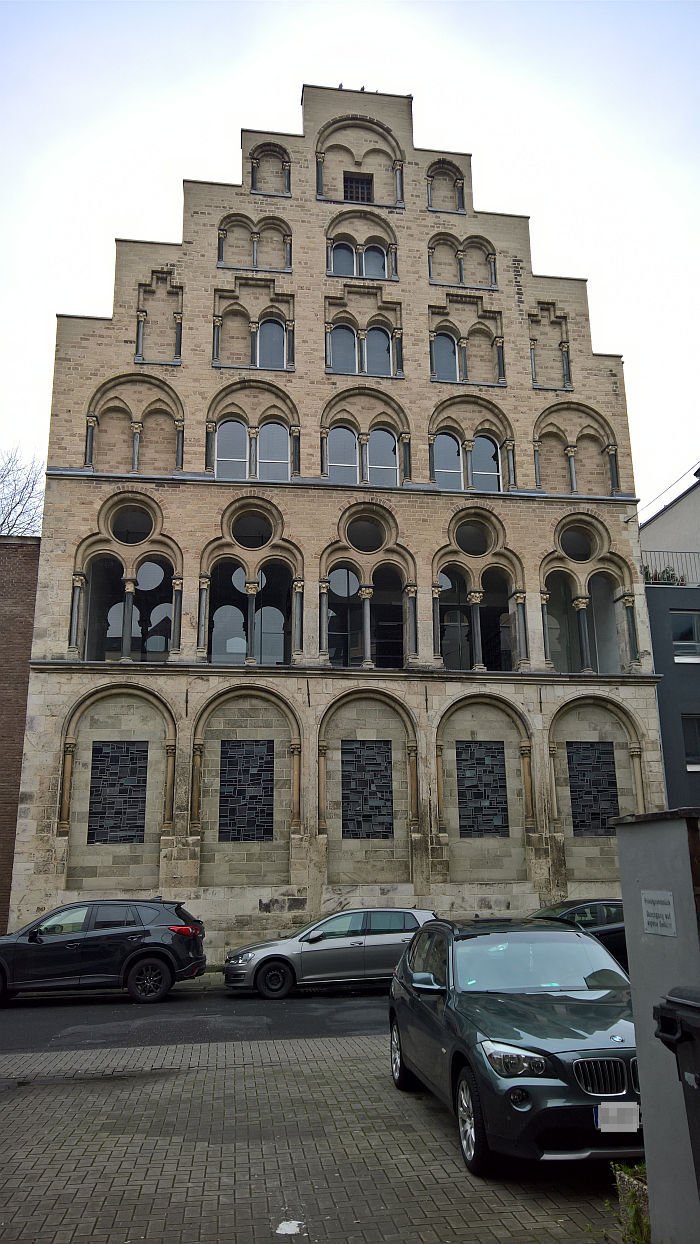
From Waidmarkt the procession turns right into Hohe Pforte, the former Roman South Gate, and which leads up past the 1930 Hochpfortenhaus by Clemens Klotz und Josef Fieth to the Roman sounding, and in many regards equally as imperialistic, Galeria Kaufhof building by Wilhelm Kreis.
One of several works realised before the First World War by Kreis for the Leonhard Tietz department store chain, and a construction which in its contemporary interpretation of classical ideals very nicely demonstrates that pared down, but striving monumentally of much of Kreis's work. Turning left you find yourself briefly sandwiched between Kries's Tietz department store and his equally restrained yet unashamedly monumental Palatium, before heading off down the, once again, rigidly straight, Schildergasse. And again a Roman legacy, specifically part of the east-west Decamanus Maximus, which in its full length ran over Jülich, Heerlen & Maastricht to Boulogne-sur-Mer and the Atlantic Coast.
One of the city's principle shopping thoroughfares the contemporary Schildergasse ends at Neumarkt where in 1823 the first Rosenmontag procession was staged, and a square every bit as linguistically confuse as Chlodwigplatz, and one which, and as with the Theresienwiese in Munich, proves that regardless of the pressures on the local housing market, a city can always afford to keep an expansive plot of land barren should it be required for the occasional pitching of a beer tent.
Prost!
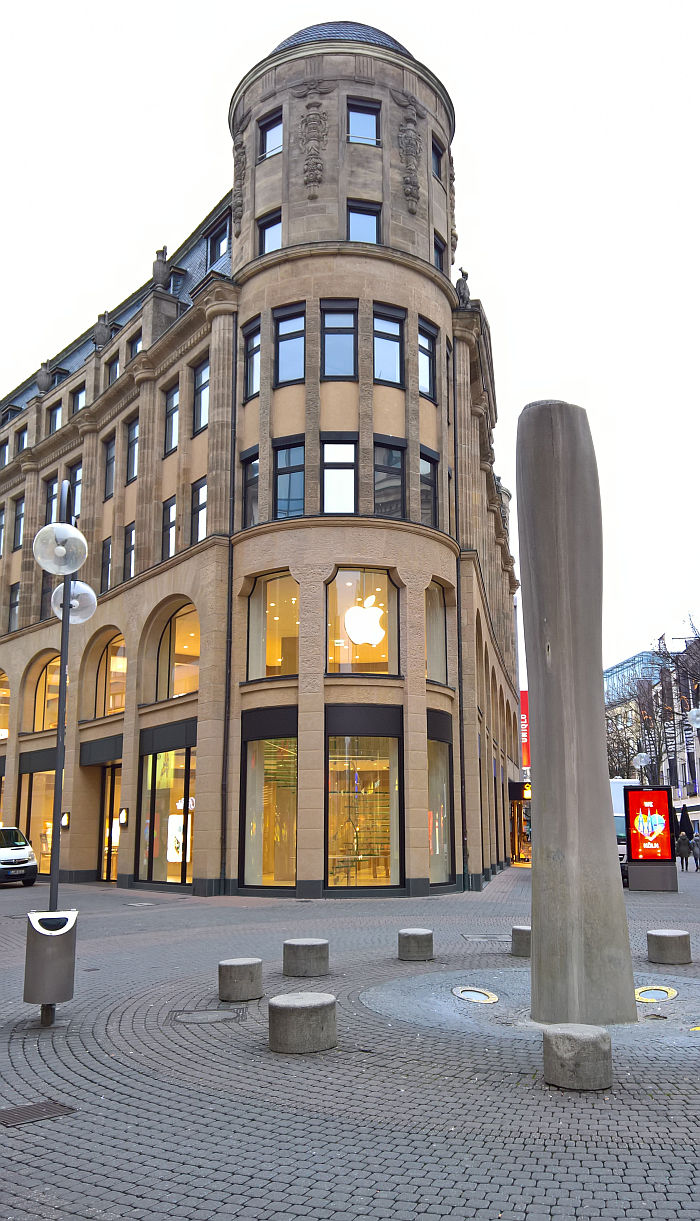
The official Rosenmontag procession leaves Neumarkt on the right-hand side continuing past the Basilica of the Holy Apostles and into Mittelstrasse. And thus a route which means missing out on the parallel proceeding Hahnenstrasse: an important thoroughfare since the middle ages, in the 1930s the Nazis planned, and failed, to develop Hahnenstrasse as a 60+ metre wide monumental boulevard; post-war a much more refined concept was developed by Wilhelm Riphahn featuring the highly characteristic, idiosyncratic, low level shops with their satisfyingly large window fronts and the equally charming Die Brücke, home of the Kölnischer Kunstverein.
Regardless of how you leave Neumarkt you arrive, via the middle ages Hahnentorburg, at Rudolfplatz, site of the former Cologne Opera, and dominated today by it's replacement, Theodor Kelter's 1961 office block für the Provinzial-Versicherung, since the mid 1980s a hotel, and thus, a very aesthetic example that buildings can change purpose, needn't be demolished to be rebuilt. If a somewhat cacological example given that Carl Moritz's 1900 historistic opera house was demolished to enable the construction of Kelter's international style inspired quadratic glass and steel construction.
Avoiding the temptation to continue on into the Belgisches Viertel, the Zoch turns right continuing down Hohenzollernring.
Much as in the mid-19th century the old Vienna city walls were demolished in order to give the city space to grow, so too in Cologne, and on the Rhein as on the Danube, the old city walls were replaced, figuratively, with a new grand boulevard. However, while Vienna managed a complete ring, the Rhein means the Cologne Ring is really a Cologne Arc, divided into 10 extended curves linked by series of squares; an arc, somewhat inevitably, and optimistically, known as the Kölner Ringe, Cologne Rings.
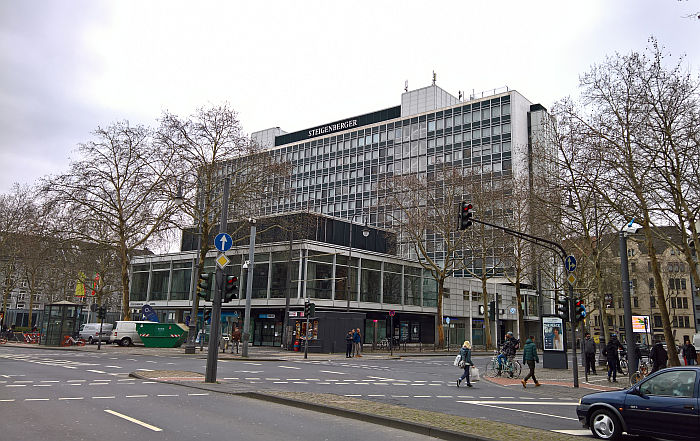
Following the Hohenzollernring to Friesenplatz, the procession turns into the Magnusstrasse, thereby ignoring the architecturally more interesting, if much narrower, Friesenstrasse. A nifty left at Auf dem Berlich would take the Zoch directly to their destination, but why when there is so much more to see; instead the route continues on past the richly ornate Römerturm to Appellhofplatz, named after the 1826 Appellationsgerichtshof [Court of Appeals], but today arguably best known for late 1960s Vierscheibenhaus created by Hentrich, Petschnigg & Partner, HPP, for the WDR.
Originally conceived as a skyscraper, a plan rejected for fear of overshadowing the cathedral, HPP instead created a low, long construction featuring, in effect, four parallel flowing buildings. And a work reminiscent of a previous construction by HPP in Düsseldorf; albeit, while the Cologne work has vier Scheiben, four slices, the Düsseldorf construction is but a Dreischeibenhaus, Three Slice House. Thus should the Düsseldorfer wish to extend their building, they could always "take a slice from Cologne"*
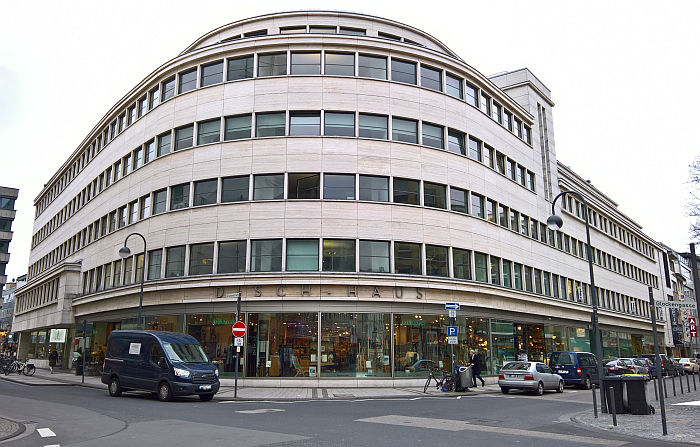
Heading back towards the Rhein the route passes along Breite Strasse, which isn't particularly breit/wide, but which was once the widest street in Cologne, and so more misnomer than solecism, before arriving at Disch Haus, built in 1929/30 by Bruno Paul and Franz Weber as the Disch Hotel and a work, allegedly, inspired by Erich Mendelsohn's Schocken department store in Chemnitz, something certainly implied in the gentle, infinite, swing of the facade and the large display windows; would however be the first recorded instance of something being successfully translated from Sächisches into Kölsch.
The Disch Haus stands, plus/minus, on the north-west corner of the former Roman Forum, whose northern border the Zoch follows to its north-east corner where today stands the new Wallraf-Richartz-Museum by Oswald Mathias Ungers and the Farina House, home of Farina, the city's oldest continually existing Eau de Cologne producer, and a product developed on that site by the Italian trader Johann Maria Farina, and named in honour of his new home city. And so less a case of Uns Sproch es Heimat, as Uns Dau es Heimat
Turning right into Quatermarkt, and thereby along the eastern border of Forum, the Zoch reaches the 15th century Gürzenich, one of the more prominent reminders of Cologne's Hanseatic past, the lower floor having previously served as a store and sales room for imported goods, the upper floor as ballroom, a function the whole building retains today, and a building which stands on the south-east corner of the former Forum. In the interests of completion, the Forum's south-west corner currently hosts an American burger restaurant, one whose logo resembles a yellowish double gateway, which we guess would make it the Arcuum Aurea - Golden Arches
From the Gürzenich the Zoch heads on towards Deutzer Brücke, another work co-authored by Fritz Leonhardt, before turning left into Heumarkt.
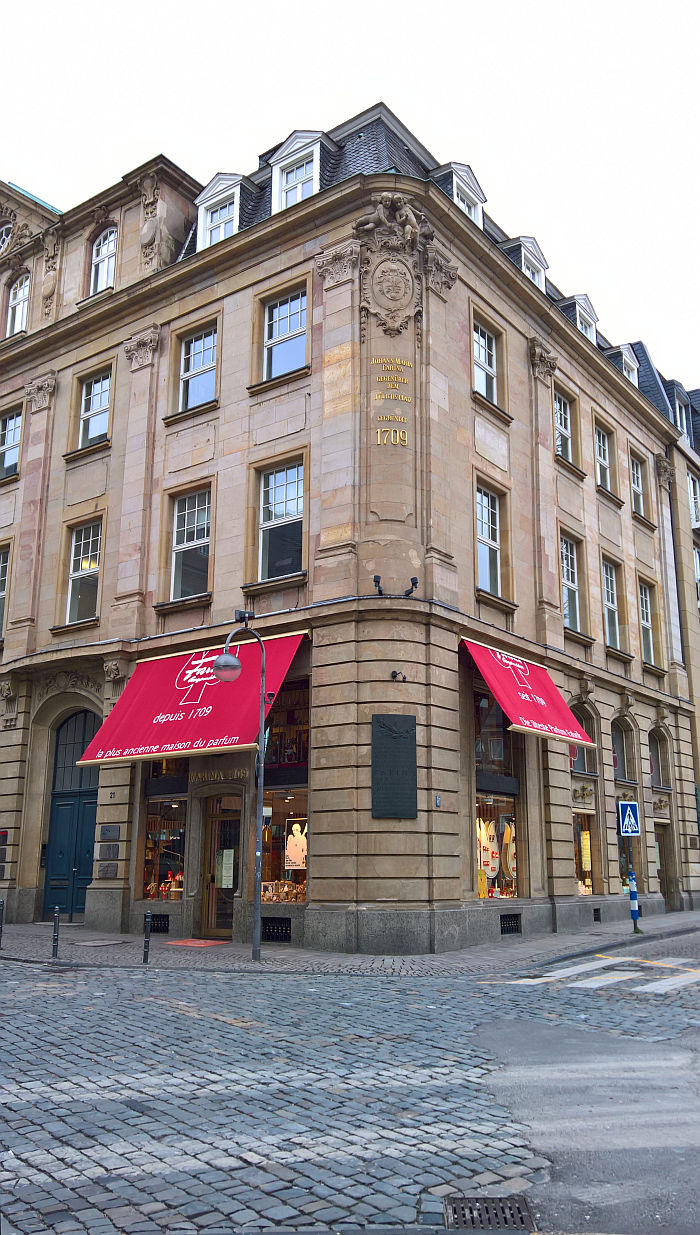
Originally to be found on an island in the Rhein the contemporary Heumarkt is not only separated from the Alter Markt with which it was previously unified, but also separated from itself: the historic Heumarkt existing today as two realities, the north part with its bars, cafes and tourists, the south part with the approach roads for the Deutzer Brücke. And a very clear longing for the bars, cafes and tourists it knows should be its. And thereby a stunning example of how poor planning can disfigure a city.
Ignoring the narrow Hanseatic alleyways that surround Heumarkt the Zoch passes on through the Alter Markt, Mühlengasse, Bechergasse and into Am Hof, and thereby past Brabanter Hof, the former residence of the Hanseatic trader Gerhard Unmaze, and the Heinzelmännchenbrunnen, a fountain realised in 1899/1900 by Edmund and Heinrich Renard and which celebrates those secretive Gnomes, Dwarves and Pixies who complete all the work in the city during the three months of the year when Cologne is busy celebrating Carnival....... the three months of the year the year when Cologne is busy celebrating Carnival!!!.... Our drum roll???
Not funny.
Doesn't normally stop you.....
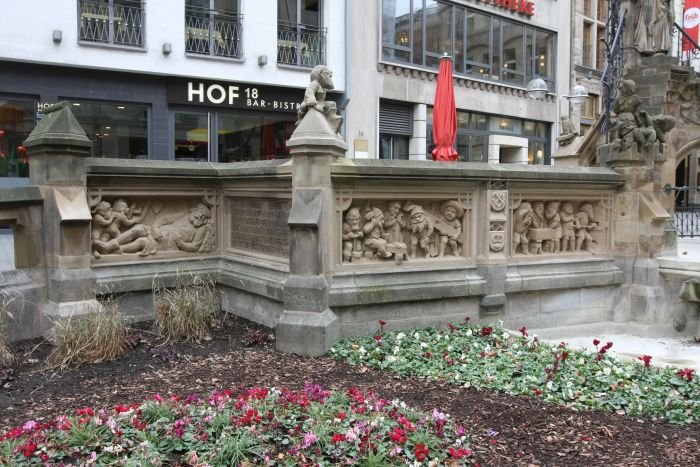
Turning right back onto the Cardo Maximus the Zoch approaches Cologne's most recognisable landmark, and one that has been more or less visible since leaving Chlodwigplatz, Cologne Cathedral. Or as the first ever Cologne city guide from 1828 put it "Our gaze once against reaches Cologne's strangest building, the cathedral" ... "Here, in all his majesty, rises the splendid work of Old German architecture, perhaps the largest and most beautiful building in the world, were it to be completed".1
Which it must almost be, for as every Kölner knows, Wenn der Dom fertig wird, geht die Welt unter. When the Cathedral is finished, the world will end
"It is difficult to describe the Cathedral worthily" notes the city guide. So we won't try. And instead turn our attention to its neighbours, including the late-1920s Haus Goldschmidt by Paul Bonatz, who as a member of the so-called "Stuttgarter Schule" represented a position to architecture contra to that of the inter-War Modernist functionalists, that such existed being all to easy to forget; and the much more flamboyant and decorative, if still pleasingly reserved, Blau-Gold-Haus. Built in 1952 by Wilhelm and Rudolf Koep for the 4711 Eau de Cologne imperium, hence the CI conform blue/gold colour scheme, the work, certainly in its contemporary guise as a home for several luxury goods brands, is for all a provocation: a temple to consumerism, the ephemeral, and the egoistic celebration of the individual, right next to the Dom. Choose your religion, choose you gospels, your relics and for all the alters of your worship.
Behind the cathedral stands Cologne Hauptbahnhof, the founders of the Cologne intelligently deciding to build their new church near the city's main transport hub
An amalgamation of works from various ages the defining feature of the contemporary Cologne Hauptbahnhof is without question the mid-1950s entrance hall by Waltenburg, Schmitt and Brunner, which continues the arches to be found over the platforms, but only to the apex; a solution which not only aids the internal illumination in an otherwise secluded location, but allows the work to shine outwards like a beacon, guiding you in. And which also neatly illustrates how in the 1950s glass and steel architecture was preferentially employed in Germany, for all as metaphor expressing a post-War openness and transparency.
Cologne Hauptbahnhof also features in the video to Encore Une Fois by Sash! .... And what's Rosenmontag without a bit of dancing, altogether now..."Mesdames, Messieurs le disc-jockey Sash! est de retour"
Passing between the Hauptbahnhof and the 1913/14 Deichmannhaus by Heinrich Müller-Erkelenz, the Zoch proceeds into Cologne's financial district. No honest. On account of its importance as a centre of international trade, Cologne has long been an important centre of finance; the above named Gerhard Unmaze being among the more prominent bankers from the Hanseatic period, while the industrialisation of the late 19th/early 20th centuries in the regions around Cologne bequeathed the city's banking industry a new boost. The latter being neatly underscored by the buildings to be found along Unter Sachsenhausen and An den Dominikanern, including works such as Carl Moritz's 1910 classic orientated Barmer Bank-Verein building, today home to the Commerzbank, or Peter Behrens' monumentally reduced 1914 work for Frank und Lehmann, today housing the HypoVereinsbank. And thereby an ensemble of works that helps demonstrate how those early 20th century architects looking to develop a clearer, more objective architectural grammar were assisted by those commercial institutions who wanted to use new understandings of architecture and design as representative of their contemporary business and economic understandings. Which of course brings us back to the Overstolzenhaus, and considerations on developments in representative architecture, including developments in relation to semantics.
Turning left at the Behrens' building, the Zoch heads towards the former Zeughaus, today the Stadtmuseum, where it rejoins the Roman wall before turning into Mohrenstrasse, one of the less fortunately named streets in Cologne but whose misfortune reminds us of the continuing legacy of historical understandings, be they of race, gender, class, religion, whatever and where it ends in front of St Gereon, a church that in a city with more churches than most cities have churchgoers, stands with its towers and decagon as a truly singular work.
St Gereon is a Patron Saint of Cologne, when it was discovered post-War that he wasn't actually ever a saint, or at least not a catholic saint, one could have expected the city authorities to reconsider his position; however, no, Cologne tending to wear its solecisms as a badge of honour.
Or put another way, Uns Sproch es Heimat!
Kölle Alaaf!
"Alles wat mer krieje künne, nemme mer och met, weil et jede Augenbleck nur einmol jitt….." In the interests of balance..... (or put another way, Helau!!)
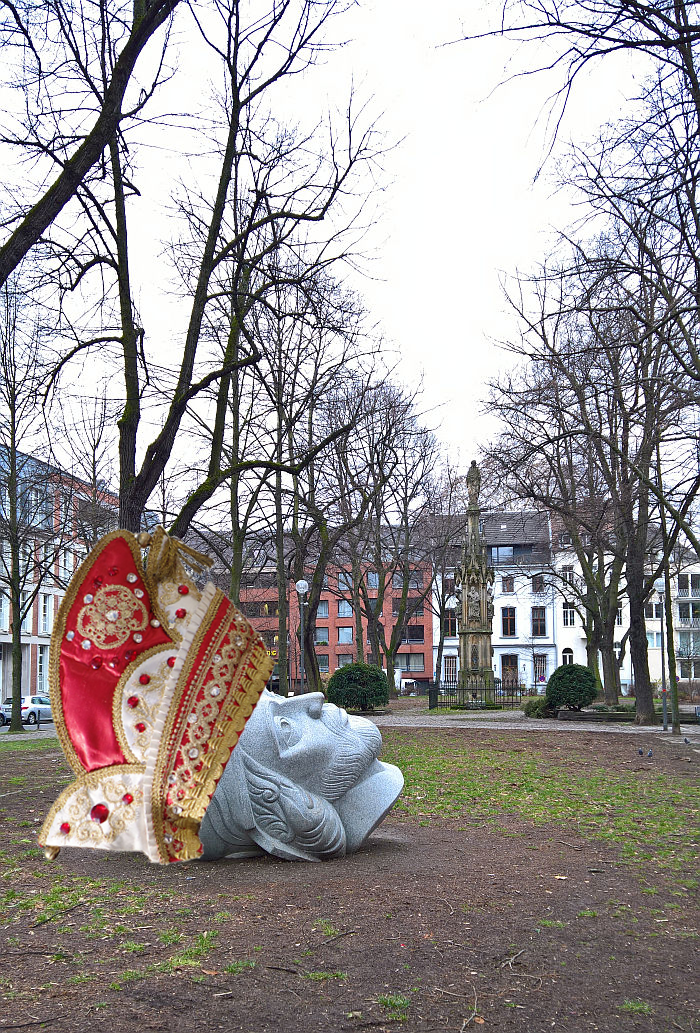
* Only works in German, "ein scheibe abschneiden" but suggests Düsseldorf should follow Cologne's example. It is the sort of provincial insult that will always win over a Cologne audience.
1Uwe Westfehling, Der erste Kölner Stadtführer: aus d. Jahre 1828, Bachem Verlag, Cologne, 1982